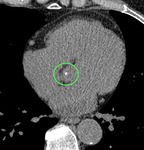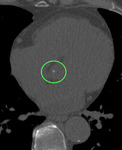Purpose
Familial hypercholesterolemia (FH) is an autosomal dominant disorder which can be caused by a mutation in the LDLR gene encoding the low-density lipoprotein (LDL) receptor (LDLR).
Early presence of coronary artery disease (CAD) and calcific aortic stenosis (CAS) are the major complications of untreated FH.
The relationship between vascular and valvular calcification is unclear.
Each may result from different pathogeneses and molecular mechanisms.
CAS was thought to be a 'degenerative' disease and part of the aging process but some evidence suggests that CAS is a...
Methods and Materials
We included to the study patients with suspicion of FH admitted to our outpatient preventive clinic between 2010 and 2013. In all patients with at least 3 points according to the Dutch Lipid Clinic Network criteria for identification of familial hypercholesterolaemia genetic testing was performed.
We included only patients with confirmed LDLR mutation to this analysis.
Cases with previous clinically apparent coronary artery disease were excluded.
Other exclusion criteria were: age < 30 years,
secondary hypercholesterolaemia,
pregnancy,
and renal insufficiency.
Finally,
72 patients (29 men...
Results
Clinical characteristics of the LDLR-M and 50 LDLR-WT patients are presented in Table 1.
We found no statistical difference in body mass index (BMI),
history of diabetes and hypertension,
or triglycerides (TG) levels between the LDLR-M and LDLR-WT groups (Table 1).
The LDLR-M group,
however had higher maximum total cholesterol (TCmax) and LDL-C max levels,
and lower on-treatment high-density lipoprotein cholesterol (HDL-C) levels.
The results of AVCS calculated using volumetric methods including AVCS distribution across calcium score ranges are presented in Table 2.
We found...
Conclusion
FH patients with LDLR mutation have an increased AVCS as assessed by computed tomography calcium scores in comparison to patients with not genetically confirmed severe hypercholesterolemia.
LDLR mutation is an independent risk factor of having high AVSC,
even after adjustment for risk factors including cholesterol levels.
These findings confirm that the evolution of aortic valve calcifications in patients with familial hypercholesterolemia appears to be,
at least in part,
independent of cholesterol levels and may result from associated processes connected with the regulatory role of LDLR...
References
1.
Yutzey KE,
Demer LL,
Body SC,
Huggins GS,
Towler D a,
Giachelli CM,
Hofmann-Bowman MA,
Mortlock DP,
Rogers MB,Sadeghi MM,
Aikawa E.:Calcific aortic valve disease: a consensus summary from the alliance of investigators on calcific aortic valve disease.
Arterioscler Thromb Vasc Biol,
2014; 34(11) :2387–93.
2.
Johnson ML,
Rajamannan N: Diseases of Wnt signaling.
Rev Endocr Metab Disord,
2006; 7(1-2): 41–9.
3.
Rajamannan NM,
Subramaniam M,
Caira F,
Stock SR,
Spelsberg TC: Atorvastatin inhibits hypercholesterolemia-induced calcification in the aortic valves via the Lrp5 receptor...




